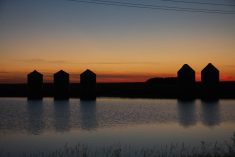A lack of research on drinking water in rural western Canada was the impetus behind a study underway at the University of Saskatchewan.
Cheryl Waldner of the School of Public Health and the Western College of Veterinary Medicine is collecting data on the source and quality of drinking water supplies in rural Saskatchewan with graduate student Lianne Mcleod.
“The primary objective (of the research) is to collect … data so that we can have an overview of what is actually happening out there,” said Waldner.
Read Also

Know what costs are involved in keeping crops in the bin
When you’re looking at full bins and rising calf prices, the human reflex is to hold on and hope for more. That’s not a plan. It’s a bet. Storage has a price tag.
She said there is no routine testing in place for private rural drinking water supplies used by many Saskatchewan farm families and as a result, the quality and safety of the water is unknown.
She conducted a smaller research project in the rural Saskatoon area last year and learned that variations in drinking water quality exist.
In this project, the researchers want to explore the source of families’ water, perceptions about water quality, beverage choices made in response to water quality and health concerns about water.
More than 6,000 surveys will be mailed to rural communities throughout Saskatchewan. Only a small percentage of the four-page surveys have been sent, but so far the response rate has been better than expected, Waldner said.
She believes the survey provides rural participants with a good opportunity to voice concerns and opinions on water supplies.
Waldner wants to compare the data gathered to health information in the province and explore any health-related links.
The information gathered will be analyzed and provided to the health regions and general public in reports that will be available on the university’s website in the fall of 2012.
Funding for the research project is provided by the Saskatchewan Health Research Foundation and the Canadian Institutes of Health Research.
For more information, visit usask.ca/~lianne. mcleod or homepage. usask.ca/~lmm937.
WATER QUALITY INDEX
The drinking water quality index provides an efficient way to rank water quality by looking at 23 commonly monitored chemicals within a community’s drinking water.
To be evaluated, water is tested for alkalinity, arsenic, hardness, dissolved solids, minerals and pH levels.
Water evaluation data produces a score between zero and 100 and in turn is ranked as poor, marginal, fair, good or excellent.
• Excellent— 95-100: Water quality is protected with a virtual absence of impairment; conditions are close to pristine levels. These index values can only be obtained if all measurements meet recommended guidelines virtually all of the time.
• Very Good— 89-94: Water quality is protected with a slight presence of impairment; conditions are close to pristine levels.
• Good— 80-88: Water quality is protected with only a minor degree of impairment; conditions rarely depart from desirable levels.
• Fair— 65-79: Water quality is usually protected but occasionally impaired; conditions sometimes depart from desirable levels.
• Marginal— 45-64: Water quality is frequently impaired; conditions often depart from desirable levels.
• Poor— Zero-44: Water quality is almost always impaired; conditions usually depart from desirable levels.
The index is not an absolute indicator of overall water safety. A community’s water may still not be safe to drink because of bacteria, a lack of minimum treatment, infrastructure deficiencies, treatment or disinfection system problems, or other unexpected occurrences.














